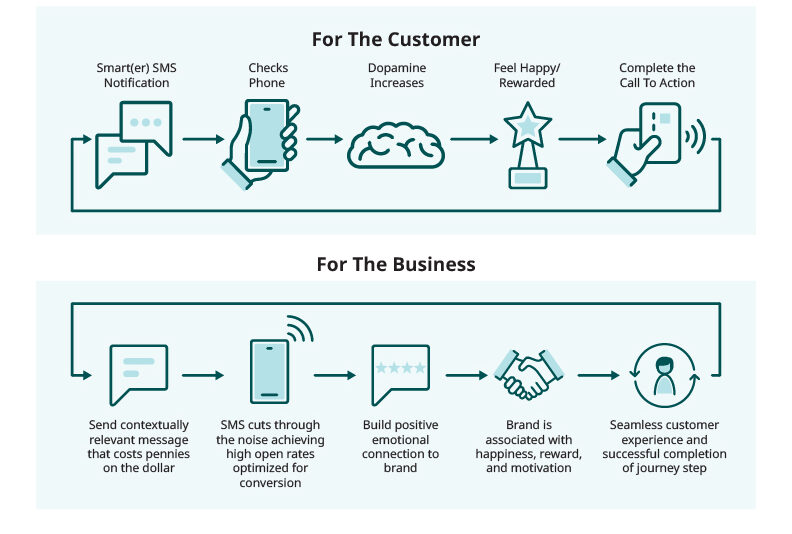Your brain chemistry wants you to text.
You feel the urge to engage at the sound of a vibrating mobile phone, the ding of the alert. It’s your Pavlov’s bell. Who could it be sending you a message? Is it work asking for help with a project, clients requiring your immediate attention, your children asking for help, or perhaps a favorite store has a sale on your go-to jeans? The world we live in has high demands for engagement at all times, in real time. Instant gratification has become a way of life. Americans check their smartphones 344 times per day (once every 4 minutes). In 2021, U.S. mobile users sent about 2 trillion SMS or MMS messages. Trillion, with a T.
Texting Is Highly Rewarding
Positive social interactions trigger a release of dopamine, the feel-good neurotransmitter that boosts mood, motivation and attention. Dopamine contributes to feelings of pleasure and satisfaction, rewarding and motivating people to repeat the behavior that produced it.
Smartphones are an abundant source of social stimuli (via texts and social media alerts and “likes,” “loves” and emotive reactions). Text message notifications have the potential to be a positive social stimulus that elevate dopamine levels. Every time checking a text message leads to a successful, rewarding social interaction (“I knew I was hilarious, and the proof is in all these replies”), the association between reading texts and the feel-good reward becomes stronger. It keeps people rushing to “answer” the text message ding. The buzz. The validation.
Related Resource: Customer Engagement Solutions Drive Transformation CX and EX Outcomes
Smart(er) Notifications: A Different Kind of CSAT
Brands can leverage this urge by utilizing SMS as a communication channel. But it’s not enough to simply notify customers—communication in the digital age must be smart(er). Smart(er) in context, personalization and timeliness. When it’s done correctly, both brands and customers win.
Customers have their phones on hand—brands have an opportunity to meet customers where they are and connect in meaningful ways. Using SMS increases brands’ access to customers and communication in their channel of choice, and, more importantly, has a positive effect on the bottom line. By streamlining interactions with a highly ubiquitous channel comes the ability to proactively deflect calls from the contact center, digitally contain customers and prompt immediate action. Compared to other channels, SMS is a very cost-effective means to simplify interaction.
For customers, receiving a text isn’t just part of daily life—it’s preference. A 2022 survey of U.S. consumers revealed that 46% of respondents like being contacted by brands via text message, with similar rates across generations: Generation X (49%), Millennials (47%), Generation Z (44%) and Baby Boomers (39%).
How is this a different kind of CSAT you ask? It drives continuous reward loops for businesses and customers.
If an interaction is not executed intelligently, it translates to bombarding customers with conflicting/random messages. A disconnected experience becomes a nuisance and negatively impacts CSAT scores. What we call a smart(er) notification is a notification that’s contextually relevant, personalized and delivered at precisely the right moment. And just like that, the phone buzzes, the screen comes alive with the notification, capturing customer attention and spurring an immediate release of dopamine in the brain. In seconds, a brief wave of delight compels the customer to complete the call to action in the text.
Repeat over and over, and you achieve a different kind of customer satisfaction—successful customer engagement that leads to exceptional experiences for happy, valued customers.
Related Resource: Smart(er) Notifications Overview
How To Deliver Smart(er) SMS Messages
Life is full of opportunities for brands to engage their customers. Customers like to be known. They expect timely messages; brands benefit from real-time engagements that double conversion rates and triple retention. Personalized interactions lead to customer loyalty. A Deloitte report noted 80% of customers are more likely to purchase from a brand that offers personalized experiences. Brands can simplify the customer experience by guiding them toward the desired action. Some everyday interactions to make smart(er):
-
-
- Order reminders (product pick-ups, prescription refills)
- Appointment reminders and confirmations (field service or medical)
- Payment reminders (bill, loan payment, debt collections)
- Problem/issue alerts (internet outages, credit card fraud)
- Cross-selling (complementary products or services)
-
CSG’s Smart(er) Notifications solution bridges our Engagement Channels with CSG Xponent, our customer engagement solution that combines a powerful customer data management platform with best-in-class customer journey management and journey analytics. By providing real-time, personalized interactive notifications in the preferred channel at the best time with the right context, Smart(er) Notifications increases engagement, propels desired customer actions, builds trusted customer relationships and loyalty, decreases churn and backlash, and increases operational efficiencies.
CSG can help you engage customers by providing a diverse contact strategy, optimized to send messages when customers will be most likely to respond. This highly customized approach benefits customers (who receive notifications when they need them) and brands (who have peace of mind knowing the message was received). Delivering personalized notifications via the channel many customers prefer—SMS—creates engagement that customers crave and brands need. Connect with our team to collaborate on a smart(er) approach to customer experience.
I’ll be right back—I just got a text my favorite luggage brand has a sale.

